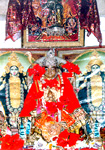


|
|

|
|
| HOME | TRAVEL | TRAVELOG | |||

The Caveman's Easel ... Bhimbetka in Madhya Pradesh
Text and photographs: Vaihayasi P Daniel
The tiny temple is extraordinarily quaint. The sadhus live in different little caves attached to the main cave where the colourful murti (idol) is located. Several cows grazing on the hillside provide the sadhus with milk and dahi.. Huge beehives -- two or three feet across -- hang from the roofs of the cave. Nearby are some ancient pieces of sculpture rescued from a nearby site that the sadhus have added to their collection of murtis and has been suitably garlanded and tikka-fied. A samadhi (tomb) of a revered sadhu baba occupies a special place close by. It must be an idyllic existence.
"How many people come. Five hundred to one thousand?" The sadhu looks aghast. "Does a fair happen with just 500 people??? Ten thousand people come here. Hundreds of stalls come selling toys, food and knick knacks." But Bhimbetka's fame does not come from this temple dedicated to Parvati. It comes from the 500 or so caves located nearby. These large, almost cosy caves wreathed in foliage, are home to hundreds of plates of prehistoric art on its walls and ceilings -- some as old as 10,000 years. In fact it is evident from these cave paintings that these spacious stone shelters have been home to man from the early Stone Age right through to the end of the Stone Age; from 10,000 to 2,000 years ago. Thus Bhimbetka has a special significance in India, and also apparently Southeast Asia, as the oldest collection of pre-historic art.
And Bhimbetka has fortunately not been discovered (accidentally or by design) by tourists, though MP Tourism has given the location some prominence. The beautiful hillside dotted with its strange stone structures and unusual topography is virtually untouched. Remote. Population free. Guide Krishna -- a farmer from Obaidullaganj who pedals every day for half an hour to his guide duties at Bhimbetka -- declares that a seven-foot skeleton was taken out of one cave and is now housed in the Indian Museum, Calcutta. Tell us what you think of this feature
|
|
|
HOME |NEWS |
BUSINESS |
SPORTS |
MOVIES |
CHAT |
INFOTECH |
TRAVEL
SHOPPING HOME | BOOK SHOP | MUSIC SHOP | HOTEL RESERVATIONS PERSONAL HOMEPAGES | FREE EMAIL | FEEDBACK |
|